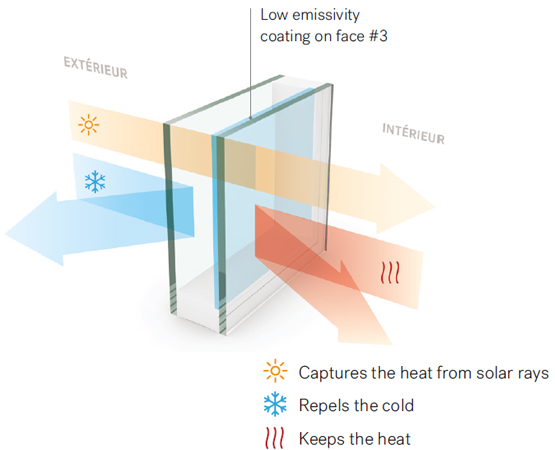During the 1980’s the introduction of low-emissivity (low-e) coatings was revolutionary, they slowed the emission of radiant energy. 37 years later the original technology has been improved for the best energy efficiency results that consumers expect.
LoĒ-i89
This coating will be found on the inside surface (room side) where it reflects the escaping heat back into the room, lowering U-factors and meeting the toughest energy guidelines as well. Coupled with our LoĒ 180 and argon fill, this double pane unit delivers near triple pane performance. What’s more, LoĒ-i89 enhanced performance glass is easy to clean and there is no haze to mar the view allowing more light to come into the room.
As the weather turns frigid, LoĒ-180 glass is the perfect cold weather remedy. It provides excellent insulating capability, blocking heat loss to the outside and reflecting heat back into the home. The dramatic improvement in comfort from the windows and the warm glass surfaces also mean the relative humidity of the indoor air can be controlled and maintained properly.
The better insulated glass, the warmer your room will be.

Benefits:
LoĒ-i89 is the new generation of low-e glass, outperforming the others all year round, especially during the cold Canadian winter months.
- Best for frigid climates
- Keeps buildings naturally warmer in winter and reduces U-Values
- Meets strict Energy Efficiency guidelines
- Clearest surface without the haze
- Can be left single-glazed to keep costs down and performs even better as a double glazed unit
- Combines with other LoE options for the ultimate performance unit
- Comes standard with Neat self-cleaning technology
- Best fading protection
- Can meet the new proposed Energy Star guidelines throughout North America
- Turn your double-pane windows into triple-pane

Low-Emissive (Low-E) Glass
Low-E glass is manufactured by depositing a microscopically thin, transparent metal or metallic oxide layer on the glass. Low-E coatings reduce radiant heat loss and can reduce the passage of UV rays. Use of heat-resistant (or absorbing) glass began in the 1950s, as did the use of reflective (or mirror) glass.
Argon Gas
Argon gas is denser than air, adding it to the captive air in double, and triple pane windows improves thermal, insulation Efficiency. Used in conjunction with special low-E glass coating, argon gas windows bring the temperature of the window closer to room temperature. This ultimately eliminates air currents and drafts that occur when differing temperatures meet.
© Copyright 2022 | All Rights Reserved